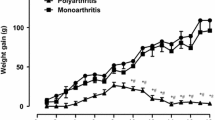Summary
The thiol status of patients with rheumatoid arthritis is significantly different from that of controls. Plasma thiol levels are lower, albumin thiol reactivity is altered and intracellular thiol levels measured after hemoglobin precipitation are increased. These variations correlate with other indices of disease severity and are one measure of a disturbance in the degree of oxidation of the blood. Penicillamine, in common with other effective therapeutic agents, produces an increase in serum thiol concentration. It causes a greater effect on serum thiol reactivity than other drugs and in particular it increases ‘fast reacting’ thiol levels without significantly altering the ‘slow reacting’ thiol level.
Similar content being viewed by others
References
Jocelyn PC (1972) Biochemistry of the SH group. Academic Press, London New York
Haataja M, Kalliomaki JL, (1977) Serum sulphydryl groups in rheumatoid arthritis. Z. Rheumatol 36:73–76
Lorber A, Bovy RA, Chang CC (1971) Sulphydryl deficiency. In: Connective tissue disorders: Correlation with disease activity and protein alterations. Metabolism 20:446–455
Lorber A, Pearson CM, Meredith WL, Gantz-Mandell LE, (1964) Serum sulphydryl determinations and significance in connective tissue diseases. Ann Intern Med 61:423–433
Munthe E, Jellum E, Aaseth J (1979) Some aspects of the mechanism of penicillamine in rheumatoid arthritis. Scand J Rheumatol (Suppl) 28:6–12
Brown DH, Smith WE (1980) The chemistry of the gold drugs used in the treatment of rheumatoid arthritis. Chem Soc Rev 9:217–240
Foster JF, (1977) Some aspects of the structure and conformational properties of serum albumin. In: Rosenoer VM, Murray O, Rothschild MA (eds) Albumin: Structure, function and uses. Pergamon, New York
Evans PH (1977) Serum sulphydryl changes in rheumatoid coalworkers' pneumoconiosis patients treated with D-penicillamine. Proc R Soc Med 70:95–97
Friedman M (1973) The chemistry and biochemistry of the sulphydryl group in amino acids, peptides and proteins. Pergamon, London
Banford JC, McNeil CJ, Brown DH, Smith WE Unpublished work
Ropes MW, Bennett GA, Cobb S, Jacob R, Jesser RA (1959) Diagnostic criteria for rheumatoid arthritis. Ann Rheum Dis 18: 49–53
Ellman GL, (1959) Tissue sulphydryl groups. Arch Biochem Biophys 82:49–53
Kamel H, Teape J, Brown DH, Ottaway JM, Smith WE (1978) Determination of copper in plasma ultrafiltrate by AAS using carbon furnace atomisation. Analyst 103:921–927
Brown DH, Buchanan WW, El-Ghobary A, Smith WE, Teape J (1979) Serum copper and its relationship to clinical symptoms in rheumatoid arthritis. Ann Rheum Dis 38:174–176
Misra HP, Fridovich I (1977) Superoxide dismutase: a photochemical augmentation assay. Arch Biochem Biophys 181: 308–312
Smith WE, Brown DH, Dunlop J, Hazelton RA, Sturrock RD, Lewis AJ (1981) The effect of therapeutic agents on serum copper levels and serum oxidase activities in the rat adjuvant model compared to analogous results from studies of rheumatoid arthritis in humans. In: Willoughby DA, Giroud JP (eds) Inflammation: Mechanisms and treatment. M.T. Press, London
Stansell MJ, Deutsch HF (1965) Preparation of crystalline erythrocuprein and catalase from human erythrocytes. J Biol Chem 240:4299–4305
Albergoni V, Cassini A (1978) The oxidation of sulphydryl compounds by caeruloplasmin. Bull Mol Biol Med 3:79–85
Pickup ME, Dixon JS, Bird HA (1980) On the effects of antirheumatic drugs on protein sulphydryl reactivity in human serum. J Pharm Pharmacol 32:301–302
Gerber DA, Shum K (1977) Histidine inhibition of the oxidation of serum protein sulphydryl groups. Arthritis Rheum 20:116
Ropes M, Perlmann GE, Kaufman D, Bauer W (1954) Electrophoretic distribution of proteins in plasma in rheumatoid arthritis. J Clin Invest 33:311–318
Thomas J, Evans PH (1975) Serum protein changes in coal-workers' pneumoconiosis. Clin Chim Acta 60:237–247
Banford JC, Brown DH, McNeil CJ, Smith WE (1982) Differences in the reaction of D-penicillamine and L-cysteine with 5,5′-dithiobis (2-nitrobenzoic acid). A model for some in vivo differences? Inorg Chim Acta 66:L 21–22
Hall ND, Gillan AH (1979) Effect of anti-rheumatic drugs on protein SH reactivity of human serum. J Pharm Pharmacol 31:676–680
Chance B, Sies H, Boveris A (1979) Hydroperoxide metabolism in mammalian organs. Physiol Rev 59:527–605
Munthe E, Guldal G, Jellum E (1979) Increased intracellular glutathione during penicillamine treatment for rheumatoid arthritis. Lancet II:1126–1127
Gerber DA (1980) Possible role of a copper complex in the pathogenesis of rheumatoid arthritis. In: Rainsford KD, Brune K, Whitehouse MW (eds) Trace elements in the pathogenesis and treatment of inflammation. Birkhäuser, Basel
Author information
Authors and Affiliations
Rights and permissions
About this article
Cite this article
Banford, J.C., Brown, D.H., Hazelton, R.A. et al. Altered thiol status in patients with rheumatoid arthritis. Rheumatol Int 2, 107–111 (1982). https://doi.org/10.1007/BF00541162
Received:
Accepted:
Issue Date:
DOI: https://doi.org/10.1007/BF00541162




